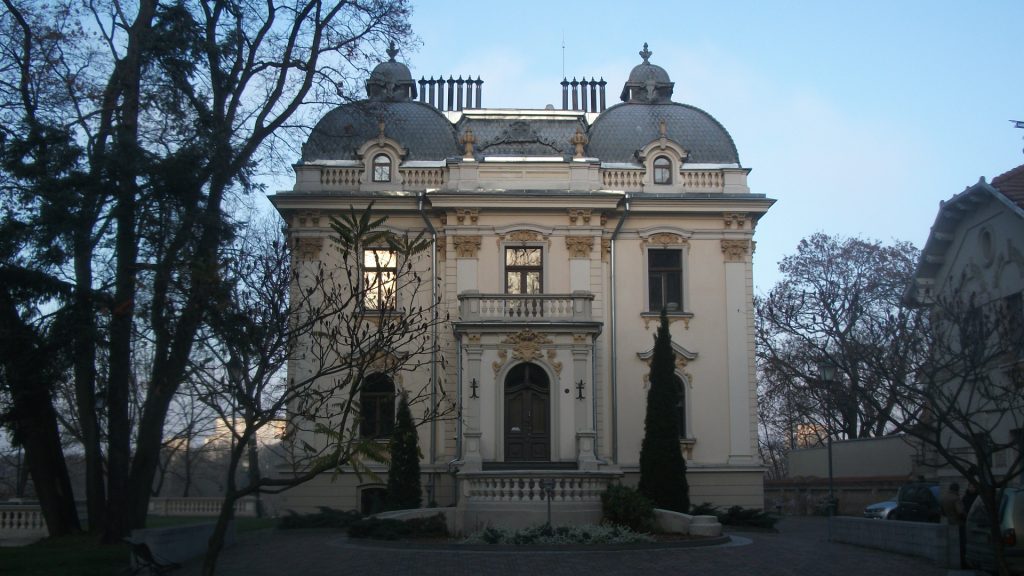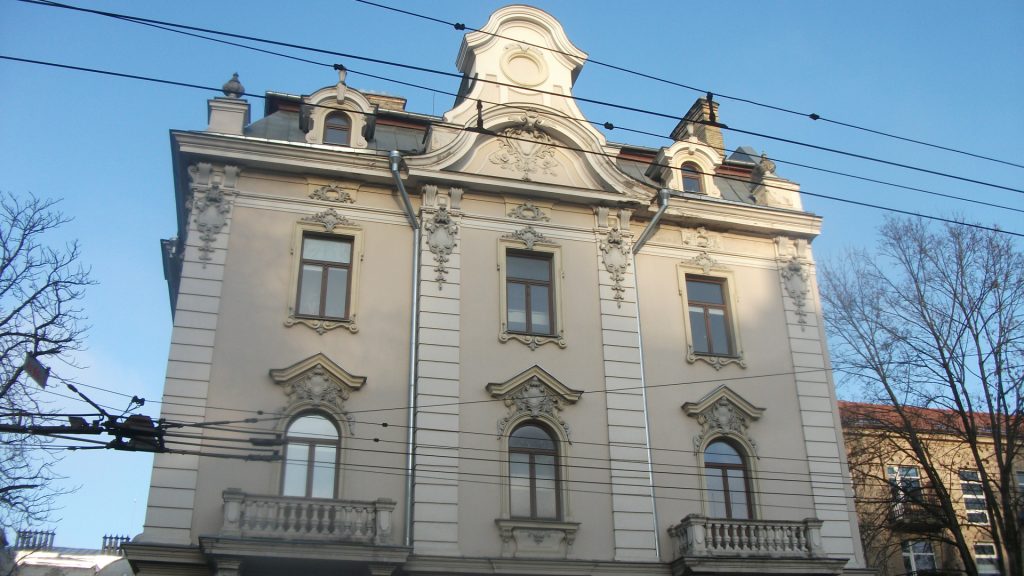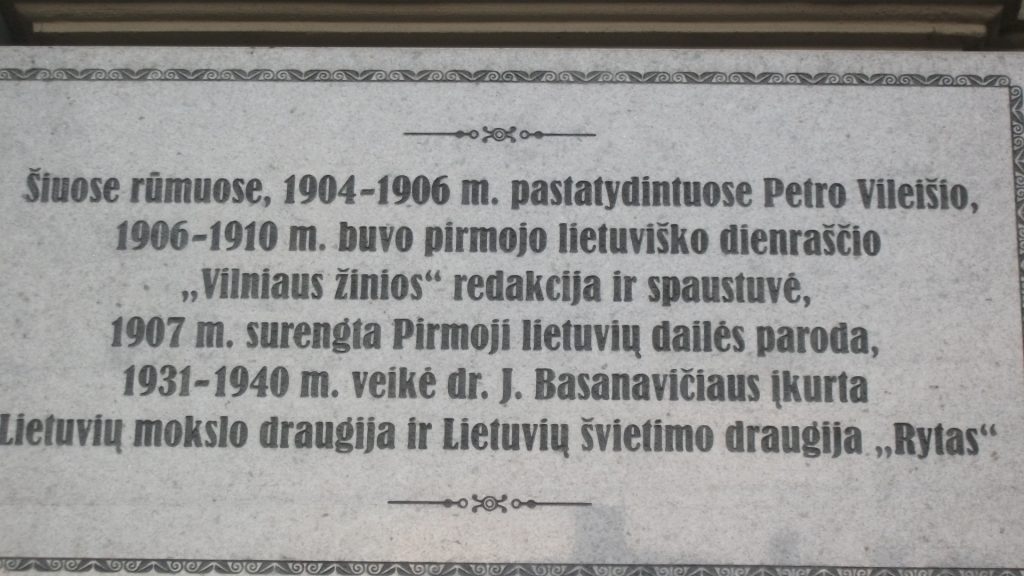Views: 391
Brothers Vileišis
There were three Vileišis brothers from Vilnius who were living from the middle of the 19th century to the beginning of the 20th century: Antanas (doctor), Jonas (lawyer) and Petras (engineer). All of them are known as the Lithuanian public and cultural figures and important persons of the rising Lithuanian national movement who were publishing books and newspapers in the Lithuanian language and gave the support to the only Lithuanian-language school and bookstore in Vilnius. The brothers as well as organized the Lithuanian art exhibitions. They were disseminating the books published in Latin (Lithuanian) script during the ban on the Lithuanian (Latin) script press in 1864−1904 during the tsarist administration of Lithuania as they succeeded to receive special permission to print a small account of such books. However, the Vileišis were at the same time supporting publishing the Lithuanian-language articles in underground newspapers and commissioning translations.

(photo by Vladislav B. Sotirović, November 2018)
Jonas Vileišis (1872−1942) became in 1918−1919 a minister of interior and a minister of finance during the revived state independence of Lithuania. He was one of the signators who signed in Vilnius an act of Lithuania’s independence on February 16th, 1918 as well as. He was also publishing the Vilnius News, the first daily in the Lithuanian language, and later the Lithuanian News.
Antanas Vileišis (1856−1919) was supporting the only Lithuanian-language two class primary school in Vilnius, which was operating under St. Nicholas Church (the oldest surviving Roman Catholic church in Lithuania built in the 14th century, Šv. Mikalojaus street) – the only church in the city which had liturgical services in the Lithuanian language.
Petras Vileišis (1851−1926) established a printing house and the Lithuanian bookstore. His house in Vilnius hosted the first Lithuanian art exhibition in 1907.
The brothers are buried in Rasų Cemetery in Vilnius.
Vileišis estate
Vileišis estate is located at Antakalnis street in Vilnius just across a famous St. Peter and St. Paul Church that is one of the fundamental Vilnius-Baroque churches examples.
Basically, a family of Vileišis had two buildings side by side in Vilnius: one (main) with a courtyard and another (residential) very closely to the street of Antakalnis.

(photo by Vladislav B. Sotirović, November 2018)
The main building (house) of Vileišis estate was built during the years of 1904−1906 in the architectural form of a mixture of neo-Baroque and Modernist styles. It was built by Petras Vileišis who was Lithuanian’s important societal person, businessman, public figure – writer and engineer. The main Vileišis building at Antakalnio Str. was designed by Vilnius architect – August Klein of the German origin.
From the very architectural viewpoint, the main building was one of the first in the city for which construction the concrete was used – a material that was at that time very rare for the construction in Lithuania. The residential house has as well as architectural peculiarities as a copper chimney was built instead of a traditional chimney constructed from the bricks and its roof was covered with lead plates which are similar to scales.
Both houses of Vileišis estate are built in a neo-Baroque with some elements of the Modernist style but in particular, it is true regarding the interior. Today, important collections of the Lithuanian studies and artworks are held inside. The Lithuanian Language Institute houses modern museum devoted to the Lithuanian language composed by the archival documents and other authentic material.

(photo by Vladislav B. Sotirović, November 2018)
Both Vileišis buildings are of significant importance for Lithuania’s history and national renaissance at the turn of the 20th century. In the residential house, the first exhibition of the Lithuanian art was organized on January 9th, 1907 when a famous public worker and a leader of the Lithuanian 19th−20th centuries national movement, Jonas Basanavičius (1851−1927) gave a patriotic speech during the opening ceremony. This exhibition of art is important and because of the fact that it was for the first time that the painting works of the most famous Lithuanian painter and composer ever, and pioneer of professional Lithuanian music, Mikalojus Konstantinas Čiurlionis (1875−1911) were displayed at the exhibit. The exhibition itself was strengthening the national feelings and identity of Lithuanians. The residential house of the Vileišis estate is important as well as for the very fact that it was a building where the Vilnius News (Vilniaus žinios) newspapers, as the first in the Lithuanian language, were printed in a printing house located in the same building where as well as the editorial board of the same newspapers operated in 1906−1910. Today, there is a memorial plaque near the main entrance to the building to commemorate this important fact from the beginning of the 20th century when the newspapers in the Lithuanian and the Lithuanian language books published in Vilnius were part of exotic reality.
Both buildings were donated in 1931 to the Lithuanian Scholarly Society and the Rytas educational society which were operating in the building until 1940. Later the houses hosted the Institute of the Lithuanian Language and the Institute of the Lithuanian Literature and Folklore. The latter is operating today in the former main house of Vileišis.

(photo by Vladislav B. Sotirović, November 2018)
Vilnius, 2019-04-05
Compiled by:
info@see-vilnius.eu
All photos are copyrighted by Vladislav B. Sotirovic
© Vladislav B. Sotirovic 2018
[wpedon id=”1558″ align=”left”]




